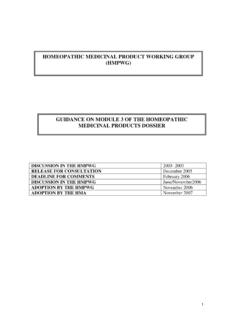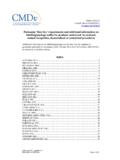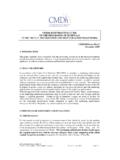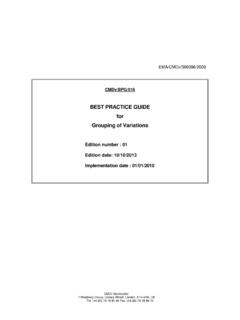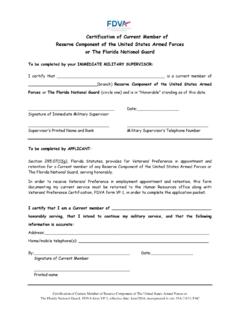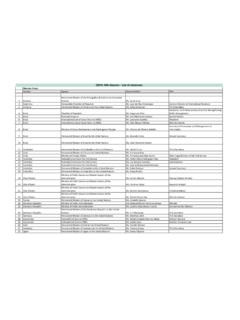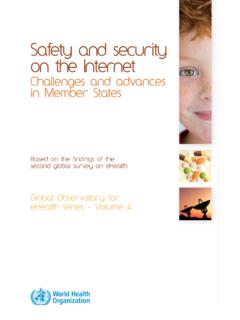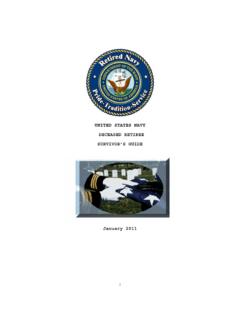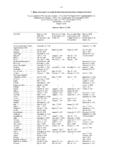Transcription of DECENTRALISED PROCEDURE MEMBER STATES’ …
1 DECENTRALISED PROCEDURE MEMBER states STANDARD OPERATING PROCEDURE October 2005 Final Revision 1 November 2007 TABLE OF CONTENTS Prerequisite: extracts from European Outline of DECENTRALISED Consultation with Making the Validation Assessment step Assessment step II, including discussion at CMD(h), if Handling of EU HBD and PSUR National Abbreviations ASMF Active Substance Master File BOS Break-Out Session DCP DECENTRALISED PROCEDURE CMD(h)Co-ordination group for Mutual Recognition and DECENTRALISED procedures for human medicines CMS Concerned MEMBER State CTS Communication and Tracking System DAR Draft Assessment Report FAR Final Assessment Report HBD Harmonised Birth Date MRP Mutual recognition PROCEDURE MS MEMBER State PL Package Leaflet PrAR Preliminary Assessment Report PSUR Periodic Safety Update Report RMS Reference MEMBER State RSI Request for Supplementary Information SPC Summary of Product Characteristics DECENTRALISED PROCEDURE MEMBER states Standard Operating PROCEDURE November 2007 Page 1/8 Introduction This document was produced by the CMD(h) in order to facilitate and harmonise the practical application of Article 28(3) of Directive 2001/83/EC as amended.
2 All time lines in this SOP are based on calendar days, days should be read as calendar days. The RMS and the applicant should be in close contact before and during the PROCEDURE in order to exchange information particularly on the time lines and how to proceed within the PROCEDURE . Prerequisite: extracts from European legislation 1- Article 28(1) of Directive 2001/83/EC as amended With a view to the granting of a marketing authorisation for a medicinal product in more than one MEMBER State, an applicant shall submit an application based on an identical dossier in these MEMBER states . The dossier shall contain the information and documents referred to in Articles 8, 10, 10a, 10b, 10c and 11. The documents submitted shall include a list of MEMBER states concerned by the application. The applicant shall request one MEMBER State to act as reference MEMBER State and to prepare an assessment report on the medicinal product in accordance with paragraphs 2 or 3.
3 2- Article 28(3-5) of Directive 2001/83/EC as amended 3. In cases where the medicinal product has not received a marketing authorisation at the time of application, the applicant shall request the reference MEMBER State to prepare a draft assessment report, a draft summary of product characteristics and a draft of the labelling and package leaflet. The reference MEMBER State shall prepare these draft documents within 120 days after receipt of a valid application and shall send them to the concerned MEMBER states and to the applicant. 4. Within 90 days of receipt of the documents referred to in paragraph 2 and 3, the MEMBER states concerned shall approve the assessment report, the summary of product characteristics and the labelling and package leaflet and shall inform the reference MEMBER State accordingly. The reference MEMBER State shall record the agreement of all parties, close the PROCEDURE and inform the applicant accordingly.
4 5. Each MEMBER State in which an application has been submitted in accordance with paragraph 1 shall adopt a decision in conformity with the approved assessment report, the summary of product characteristics and labelling and package leaflet as approved, within 30 days after acknowledgement of the agreement. Outline of DECENTRALISED PROCEDURE The DECENTRALISED PROCEDURE will be divided in five steps: - Pre-procedural step, including validation phase - Assessment step I - Assessment step II - Discussion at the CMD(h), if needed - National step DECENTRALISED PROCEDURE MEMBER states Standard Operating PROCEDURE November 2007 Page 2/8 Pre-procedural step, including validation phase Consultation with RMS It is recommended that the applicant informs the MEMBER State (MS) chosen as Reference MEMBER State (RMS) that an application under the DECENTRALISED PROCEDURE is planned, as soon as the applicant has an estimation of the intended submission date of the application.
5 The RMS will allocate a PROCEDURE number to this application (according to the numbering system described in Chapter 2 of the Notice to Applicants) and will inform the applicant accordingly. The applicant should seek regulatory advice or prediscuss the application with the RMS either during a presubmission meeting or via a teleconference/e-mail at least 2 months before submission of the dossier. The applicant has drafted the package leaflet (PL) within its development programme. The applicant has considered the need for user consultation and undertaken initial testing as necessary or the applicant indicates that user consultation will be done during the clock-off period. Discussion with the RMS indicates whether user consultation may be necessary or expert justification for its absence is likely to be acceptable. In the case of possible different views among MSs on the legal basis of the application the matter can be discussed in the meeting of the Co-ordination group for Mutual Recognition and DECENTRALISED procedures (CMD(h)) prior to the application but also during the validation phase, to be initiated by the RMS.
6 The RMS creates the PROCEDURE in the CTS database as soon as the dossier is submitted, so that CMS and RMS are able to communicate on the PROCEDURE through the CTS record immediately after receipt of the dossier. Making the application The applicant submits an application to the National Competent Authorities of each of the MS where a marketing authorisation is to be sought. The applicant is required to give assurance, usually in the cover letter accompanying the application, that the dossier submitted is identical in all MSs concerned (RMS + CMSs). The application should be made according to the legal basis applied for. Guidance on format, appropriate number of copies of the dossier, languages requirements, fees etc. can be found in Chapter 7 of the Notice to Applicants. Text proposals for SPC, PL and labelling in English only are acceptable with the submission of the dossier1.
7 Sample mock-ups in an official language of the EU should be submitted for the application to be valid. The applicant notifies the RMS of the dates of dispatch of the dossier, so that the RMS is able to update the CTS record and to complete the date of last dossier submission in CTS. This date of last dossier submission is the start of the validation period. At the time of updating the CTS record, validation of the application does not have to be completed by the RMS. Validation phase 1 Due to national legal requirements in Poland, Polish translations of the SPC, PL and labelling are required before the start of a DCP. DECENTRALISED PROCEDURE MEMBER states Standard Operating PROCEDURE November 2007 Page 3/8 The application should be checked in by all MSs concerned (RMS + CMSs). The check can be made according to the check-in PROCEDURE described in Chapter 7 of the Notice to Applicants or using any other appropriate form.
8 Both RMS and CMSs should promptly inform the applicant and the CMSs/RMS about any validation issues (administrative and regulatory issues). The MSs should indicate in CTS that the application is invalid when there are justified reasons to do so. An application will not automatically be set invalid if a MS has not yet received the dossier and the validation period has not started. If, at day 7 of the validation period the CTS record is not complete with respect of valid or invalid application for each MS, the RMS will notify (initially by Eudranet email) the CMS who have not completed the CTS record that the validation period will close at the end of the next 7 day period unless notification of an invalid application is received. The RMS will close the validation period 7 days after this notification, if the RMS has declared the application valid, and may start the PROCEDURE unless informed by a CMS that the application is not valid.
9 If a CMS has previously informed the RMS that the application is not valid, the PROCEDURE will not be started until that CMS confirms to the RMS that the issue has been resolved and the application is valid. The CMS has a duty to update the CTS record accordingly. The CMS must inform the RMS that the application has become valid within 7 days of the missing information being supplied. If it is not expected that the application will become valid within an acceptable time, the applicant will be advised to withdraw the application in the MS. If the application is withdrawn in a CMS during the validation period (before start of the PROCEDURE ) the PROCEDURE should be regarded as finalised in that CMS. So this CMS should not receive any further communication/e-mails/documents related to this PROCEDURE . It is then considered that this CMS did not participate in the PROCEDURE . The RMS confirms to CMS (via CTS) and applicant the start of the PROCEDURE and the updated timetable, if necessary.
10 Assessment step I The assessment step I corresponds to the 120-day period for preparing Draft Assessment Report (DAR) and comments on draft SPC, draft PL and draft labelling. The RMS forwards the Preliminary Assessment Report (PrAR) (including comments on SPC, PL and labelling) on the dossier to the CMSs and the applicant within 70 days after the start of the PROCEDURE . This PrAR will include a comment on whether user consultation of the PL has been performed or is foreseen, or the justification for its absence is acceptable. The RMS will have the main responsibility for the assessment of the PL. By Day 100 CMSs should communicate their comments to the RMS, CMS and applicant, using the template agreed upon, differentiating between potential serious risks to public health and points for clarification. Any issues should be carefully screened within national agencies. If a CMS raises a potential serious risk to public health it shall give a detailed exposition of the reasons of its position.
